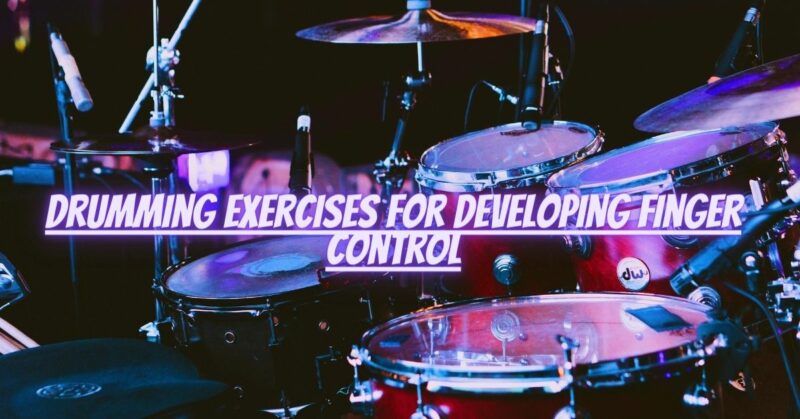Finger control is an essential aspect of drumming technique that allows drummers to achieve precision, speed, and expressiveness on the drum kit. Developing strong finger control enhances your ability to execute intricate patterns, ghost notes, and dynamic nuances. In this article, we will explore a series of drumming exercises designed to help you improve your finger control, enabling you to unlock new levels of finesse and versatility in your drumming.
- Finger Control Warm-up: Begin your practice session with a finger control warm-up exercise. Place your hands in a relaxed position on the snare drum, and alternate between your fingers to produce controlled and even strokes. Start at a slow tempo, gradually increasing the speed as you become more comfortable. Focus on maintaining consistency in the volume and quality of each stroke, allowing your fingers to do the work rather than relying on arm or wrist movements.
- Finger Independence: To improve finger independence, practice exercises that isolate each finger. Start by playing a simple pattern, such as RLRL on the snare drum, while keeping your other fingers lifted off the drumhead. Gradually increase the tempo while maintaining clarity and control. Repeat the exercise with different finger combinations, such as RRLR, LRLR, or RLLR, to strengthen the independence and coordination of each finger.
- Finger Rolls: Finger rolls are an effective exercise for developing finger control and finesse. Begin with a single-stroke roll on the snare drum, playing each stroke with a finger rather than a wrist or arm motion. Focus on producing clean and even rolls by using a combination of finger strength and rebound. Gradually increase the speed while maintaining control, striving for a smooth and seamless roll.
- Accent Control: Working on accent control is crucial for developing finger control and dynamics. Start by practicing a simple accent pattern, such as RLrl, on the snare drum. Emphasize the accented strokes by playing them with a stronger finger stroke, while keeping the unaccented strokes light and controlled. Experiment with different accent patterns and incorporate them into grooves and fills to enhance your drumming dynamics.
- Finger Speed Exercises: To improve finger speed, practice exercises that involve rapid single strokes. Begin by playing a steady stream of 16th notes on a practice pad or snare drum, focusing on using your fingers to generate the speed. Start at a slow tempo and gradually increase the speed while maintaining control and accuracy. Pay attention to maintaining an even sound and volume between each stroke.
- Incorporate Rudiments: Many traditional drumming rudiments can be adapted to enhance finger control. Incorporate rudiments such as single stroke rolls, paradiddles, and flam accents into your practice routine. Start at a slow tempo, ensuring that each stroke is clean and controlled. Gradually increase the speed while maintaining precision and consistency.
- Drumming Patterns: Apply your finger control exercises to drumming patterns that you encounter in different musical styles. Practice grooves and fills that require intricate finger control, such as ghost notes, quick double strokes, and complex patterns involving the hi-hat, snare, and bass drum. Focus on executing the patterns with precision, clarity, and a relaxed finger technique.
Conclusion: Developing finger control is a continuous journey that requires consistent practice and patience. By incorporating these exercises into your regular practice routine, you can strengthen your finger control, enabling you to execute intricate patterns, ghost notes, and dynamic nuances with finesse and accuracy. Remember to start slowly and gradually increase the speed as your control and speed improve. Regular practice, along with a focus on precision, dynamics, and relaxation, will help you refine your finger control and elevate your drumming to new levels. Embrace the challenge, stay disciplined, and enjoy the process of fine-tuning your fingers to become a more versatile and expressive drummer.


